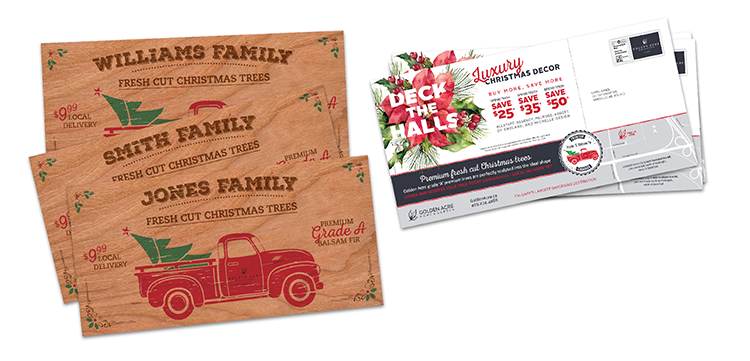11.23.2023
If you’re a marketer, you know firsthand how quickly the marketing landscape shifts. But as algorithms update and trends come and go, there’s one tried and true traditional marketing tactic that has stood the test of time—and that’s direct mail marketing.
In a marketplace driven by digital experiences, direct mail alone may not give you the results you’re looking for. However, research shows that integrating direct mail with more modern digital marketing and data-driven strategies can create powerful campaigns. In fact, people pay 39% more attention to integrated direct mail and digital campaigns than they do to single-media digital campaigns. Just imagine the impact that could have on your campaign results and ROI!
TL;DR — Integrating digital marketing and data-informed strategies with direct mail can enhance the effectiveness of both. To get your creative marketing gears turning, here are three innovative ways to merge digital and physical for maximum impact, including:
1) Personalized URLs and QR Codes
One of the most effective ways to integrate digital marketing into direct mail is by using Personalized URLs (PURLs) or QR codes. These tools create a seamless transition from a physical mail piece to a digital platform. Here’s how it works:
PURLs: These are unique, personalized web addresses included in your direct mail piece. When a recipient types this URL into their browser, they're taken to a highly personalized landing page that might greet them by name and offer tailored content or special deals based on their preferences or past interactions with your brand.
QR Codes: These are scannable codes printed on your mail piece. While QR codes have been overused in some aspects of marketing, print materials are where they really shine. When scanned with a smartphone, they direct the recipient to a specific web page. This could be a promotional video, a sign-up form, or a special offer.

Using PURLs or QR codes allows you to track engagement levels and gather data on your audience’s preferences, which couldn’t be achieved without the digital aspects of the campaign. These methods provide real-time insights on landing page visitors and conversions, so you can more accurately measure the ROI of your integrated marketing campaign. That’s a major win!
Using QR Codes on Neighbourhood Mail
Neighbourhood Mail™ is one of three categories of direct mail marketing offered by Canada Post. Because it targets generalized neighbourhoods or regions, it’s ideal for mass awareness campaigns if you’re looking to acquire new customers.
If you live in Canada, you likely receive Neighbourhood Mail™ often because it is the least targeted and most economical option of the three. Whether it’s your local pizza shop or home hardware store, small businesses often send postcards or pamphlets via Neighbourhood Mail™. To streamline the customer experience, they’ll add a QR code to lead the customer back online without having to type in a URL manually.
Next time you check the mail, see if you can find a piece of direct mail with a QR code on it and let us know—do you think this tactic is effective?
2) Leveraging Customer Data for Targeting
From your social media accounts to past order addresses—your marketing team is sitting on a goldmine of customer data and insights. Leveraging these insights, you can create highly targeted direct mail campaign lists to significantly increase the relevance and impact of your mailer. Here's how:
Analyze your audience
Dive into your audience insights to better understand their preferences, interests, and buying habits. This could include demographic data including household income, locations, age and marital status. But depending on the nature of your business, you could also go deeper into things like the type of car they own, whether they like to take winter vacations, or whether they live in an older home.
How is all this relevant? Well, you’ll have to read on to find out.
Find similar customers
Say you own a roofing business and you want to send marketing messages only to areas where people live in older homes that may need new roofing. Or perhaps you’re an auto dealer looking to sell more inventory of pre-owned cars. By segmenting your data to give you a list of customers that have previously purchased these things from you, you can use Canada Post’s Postal Code Targeting services to find similar customers.
How does it work? Because you likely have your customer’s addresses on file from past order details, you can use Postal Code Targeting to send direct mail campaigns to postal codes that have similar audience attributes to your existing lists. This method of targeting is based on the old adage, “birds of the same feather flock together.” Meaning, people generally live in the same area as similar people.
Imagine if you saw a neighbour getting their roof updated, and days later, you received a direct mail piece that says, “Your neighbour just got their roof done. Now it’s your turn!” with a 10% off promo. Could that level of personalization urge you to take action?
3) Synchronizing Email and Direct Mail
Combining email marketing with direct mail creates a multi-touchpoint campaign that reinforces your message. Here’s a simple strategy to integrate the two:
Begin with an email announcing a special offer or a piece of valuable content.
Follow up with a direct mail piece that delivers on the promise made in the email. This could be a detailed brochure, a sample product, or a personalized discount code.
Use a subsequent email to follow up on the direct mail piece, perhaps asking for feedback or offering additional related online content.
In this type of campaign, Personalized Mail is your go-to method. Personalized Mail is a one-to-one approach that mails a specific recipient and is personally addressed with their name. This works best for marketing to existing customers or to a list of previously engaged prospects who might already be familiar with your brand.
Personalized Mail is often used for scenarios like inviting people to events, soliciting donations, reporting financial performance to stakeholders, or supporting loyalty card programs.

Can you think of a time a company sent you a marketing message and followed up with a piece of direct mail? Many leading brands use this integrated method to nurture their audience. Sephora uses this method to market their Beauty Insider program and exclusive discounts, while Questrade uses it to send financial statements to their account holders.
This synchronized approach ensures that your brand stays top-of-mind, as recipients encounter your message across multiple channels. The opportunities are truly endless!
Curious About Creating a Direct Mail Campaign?
Integrating digital marketing with direct mail creates a holistic approach that leverages the strengths of both. The key is to ensure that each element of the campaign complements and reinforces the others, creating a unified, multi-channel marketing strategy. With these tactics, your business can enhance engagement, improve response rates, and drive a higher ROI on your marketing campaigns.
To dive deeper into the world of direct mail and learn how to build out your very own campaign, access our FREE 6-Step Guide to Direct Mail Marketing. Or if you’d rather not go it alone, learn how WCD can help you create your direct mail campaign—from strategy to design, printing, mailing and beyond.



